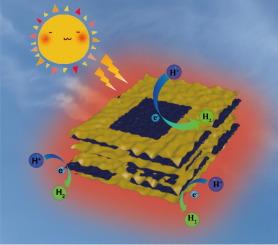2D/2D NiPS3/g-C3N4 heterojunctions for photothermal-assisted photocatalytic hydrogen evolution
IF 9
1区 工程技术
Q1 ENGINEERING, CHEMICAL
引用次数: 0
Abstract
The process of Photocatalytic Hydrogen Evolution (PHE) represents a reliable method for addressing the energy crisis. In this work, a self-assembly method was performed to combine 2D NiPS3 (NPS) nanosheets (Ns) with 2D C3N4 (CN) Ns to prepare NPS Ns/CN Ns (NPCN) 2D/2D heterojunctions with intimately interfacial contact between these two components. Compared to CN Ns, NPCN photocatalysts possess wide-spectrum light absorption regions, excellent light-to-thermal energy effect, electron mobility, charges transfer, and abundant surface active site, thus leading to the enhanced PHE performance for NPCN composites in natural seawater and simulated seawater. Meanwhile, the negative effect of the added various ions on the PHE performance was revealed over 2-NPCN using different typical aqueous solutions. The first-principle calculations and experimental analysis were performed to gain a deep understanding of the underlying mechanisms responsible for the exceptional HER activity over NPCN composites. Drawing from the characterization and DFT calculation results, a photothermal-assisted PHE mechanism was proposed over NPCN composites. This work provides a strategy for the design and synthesis of efficient, stable and highly active g-C3N4-based heterojunctions.


2D/2D NiPS3/g-C3N4异质结用于光热辅助光催化析氢
光催化析氢(PHE)是解决能源危机的可靠方法。在这项工作中,采用自组装方法将2D NiPS3 (NPS)纳米片(Ns)与2D CN Ns结合,制备了NPS Ns/CN Ns (NPCN) 2D/2D异质结,这两种组分之间具有密切的界面接触。与CN Ns相比,NPCN光催化剂具有广谱光吸收区、优异的光热效应、电子迁移率、电荷转移和丰富的表面活性位点,从而使NPCN复合材料在天然海水和模拟海水中的PHE性能得到增强。同时,在2-NPCN的不同典型水溶液中,揭示了不同离子的加入对PHE性能的负面影响。进行第一性原理计算和实验分析,以深入了解NPCN复合材料异常HER活性的潜在机制。根据表征和DFT计算结果,提出了NPCN复合材料的光热辅助PHE机理。这项工作为设计和合成高效、稳定和高活性的g- c3n4基异质结提供了一种策略。
本文章由计算机程序翻译,如有差异,请以英文原文为准。
求助全文
约1分钟内获得全文
求助全文
来源期刊

Separation and Purification Technology
工程技术-工程:化工
CiteScore
14.00
自引率
12.80%
发文量
2347
审稿时长
43 days
期刊介绍:
Separation and Purification Technology is a premier journal committed to sharing innovative methods for separation and purification in chemical and environmental engineering, encompassing both homogeneous solutions and heterogeneous mixtures. Our scope includes the separation and/or purification of liquids, vapors, and gases, as well as carbon capture and separation techniques. However, it's important to note that methods solely intended for analytical purposes are not within the scope of the journal. Additionally, disciplines such as soil science, polymer science, and metallurgy fall outside the purview of Separation and Purification Technology. Join us in advancing the field of separation and purification methods for sustainable solutions in chemical and environmental engineering.
 求助内容:
求助内容: 应助结果提醒方式:
应助结果提醒方式:


